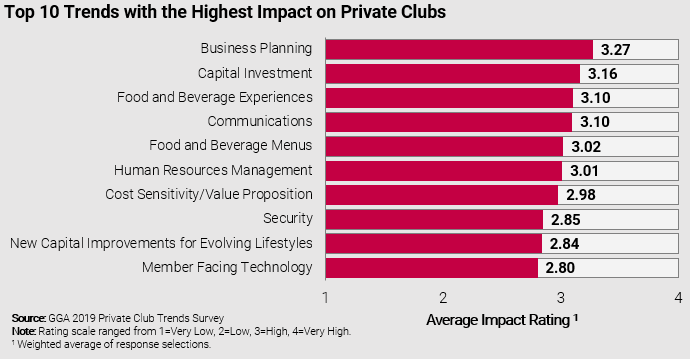Business Planning is the number one trend in the private club sphere for 2019, with club managers citing it as having the highest impact on club operations in today’s market.
GGA Partner, Rob Hill, looks at why this was…
Private club managers are working to meet demands for a better plan.
This was the clear finding of a recent survey of managers recently conducted across North America, with valuable contributions from several leading European clubs.
While many may see this as nothing new, the survey did reveal a number of interesting reasons behind this trend, with changing markets and changing member expectations driving the need for a more forward-thinking approach among club leaders.
A wave of change
Europe and North America both face a challenging macro-environment in 2019, with Morgan Stanley Research predicting a growth drop of around 0.6% for the United States, and 0.3% in the Eurozone*. With uncertainty fueling a lack of investor and consumer confidence, both are making more careful, considered and longer-term choices.
Alongside this uncertainty in the markets, the needs, wants and demands of club members are also evolving rapidly, creating a shifting landscape in which it is no surprise that business planning has surfaced as the most impactful trend among private club managers.
Trends within trends
Of course, the notion of business planning itself is nothing new. The need to produce and update a plan with board members at regular intervals is an ever-present duty for club leaders.
That said, a closer analysis of manager’s survey responses reveals interesting trends within this process that help explain why it is only growing in importance:
Wanting more – with lower levels of consumer confidence and greater scrutiny of expenses, members are understandably looking for greater value where they do choose to spend. As one manager put it, “Members want much more nowadays – so we need to provide more services, and plan for what they are and what members need.”
Typically, this means expanding amenities and services, as well as creating greater differentiation from other competing leisure pursuits – many of which do not require the same level of time and financial commitment, making them easier to justify.
Experiences – the advent and increasing popularity of investing in experiences over products is well-documented, and is now permeating through to clubs.
Survey responses indicated that clubs are becoming more mindful of this trend, with one respondent stating the need to “develop creative solutions and unique experiences which members will value.”
While clubs are coming to understand the need to craft and deliver exceptional experiences for their members, these experiences need to be carefully informed, appropriately financed and properly planned to ensure you fulfill this ever-growing demand among the membership.
Rising costs – increased member demands for new services and amenities are contributing to rising operations costs across much of the industry. In this landscape, business planning will play a pivotal role in ensuring financial stability, mitigating the impact of increased competition, and securing the longevity of the club – both as a business and as a relevant destination to existing and prospective members.
Where to start
As important as it is to know how to start a plan, it’s just as critical to know who is responsible for it. Managers involved in the survey spoke of the need to ‘free up’ the board to think more in a strategic context, rather than just an operational one. This can empower the board to inform a far-reaching, evidence-backed vision and plan for the club which all stakeholders can unite behind.
Club managers can then operate with the freedom to develop greater agility in making real-time decisions, to source the right information to support them, and to implement process management and ‘total work’ systems that will see the plans through.
Attention to detail
In expanding their amenities and services, many clubs are evolving from small businesses into larger, multifaceted entities which require increasingly specific, detailed, and timely plans of action. A combination of economic interests, resource limitations, and evaluations of financial viability are compelling clubs to think longer-term and to plan more diligently.
In a world that continues to change at tremendous pace, it is easy for business leaders to feel out of control. And this gets to the heart of why, we believe, business planning emerged in this survey as the trend with the highest impact on clubs today.
However, by arming yourself with the best tools at your disposal, tools that will enable you to take swift, measured, evidence-backed action, you will be well-equipped to face the challenges of both the present and of the future.
*Morgan Stanley Research “2019 Global Macro Outlook: Emerging Markets Retake the Lead” (Nov. 25, 2018)
This article was authored by GGA Partner Rob Hill.












